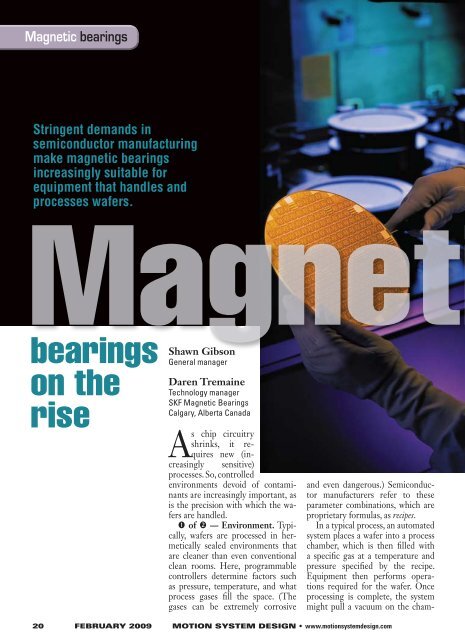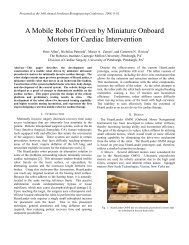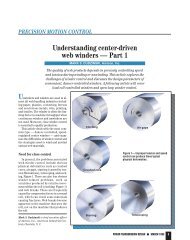You also want an ePaper? Increase the reach of your titles
YUMPU automatically turns print PDFs into web optimized ePapers that Google loves.
<strong>Magnetic</strong> bearingsStringent demands insemiconductor manufacturingmake magnetic bearingsincreasingly suitable forequipment that handles andprocesses wafers.Magnetibearingson theriseShawn GibsonGeneral managerDaren TremaineTechnology managerSKF <strong>Magnetic</strong> <strong>Bearings</strong>Calgary, Alberta CanadaAs chip circuitryshrinks, it requiresnew (increasinglysensitive)processes. So, controlledenvironments devoid of contaminantsare increasingly important, asis the precision with which the wafersare handled. of — Environment. Typically,wafers are processed in hermeticallysealed environments thatare cleaner than even conventionalclean rooms. Here, programmablecontrollers determine factors suchas pressure, temperature, and whatprocess gases fill the space. (Thegases can be extremely corrosiveand even dangerous.) Semiconductormanufacturers refer to theseparameter combinations, which areproprietary formulas, as recipes.In a typical process, an automatedsystem places a wafer into a processchamber, which is then filled witha specific gas at a temperature andpressure specified by the recipe.Equipment then performs operationsrequired for the wafer. Onceprocessing is complete, the systemmight pull a vacuum on the cham-20 FEBRUARY 2009 MOTION SYSTEM DESIGN • www.motionsystemdesign.com
cber to remove process gases. Thennew gases can be introduced, andadditional operations performed onthe wafer, as required. Gas removaland vacuum creation are done usingturbomolecular pumps, or TMPs.What is happening is that the automatedsystem is accumulating (layer-by-layer)required wafer circuitry.Elements are deposited, then someare removed, and then new elementsare added. Gradually, all requiredlayers are applied to the wafers —The demand for more compactelectronic products has drivenmicrochip manufacturers tobuild increasingly complex chipcircuitry while maintaining andoften decreasing chip size. Infact, state-of-the-art chips nowhave circuitry with structurewidths of 45 nanometers orless. These chip structuresare built by up to 300 processsteps of deposition, removal,patterning, and modification ofsilicon wafer electrical properties.Sophisticated semiconductorequipment performsthe required atomic layerdeposition, photolithography,and rapid thermal annealing.Shown here is the final inspectionprocess.but in order to do that with requiredcleanliness, the environments mustbe well regulated. of — Motion control. Giventhe precision required to producecircuitry measured in nanometers,chip manufacturers must know theexact location of a wafer during installationof its circuit elements. Ofcourse, different applications havedifferent positioning precision requirements,but the operative termencompassing both positioning andvibration is active control.With TMPs and excimer laserblowers, the ability to actively minimizevibration is particularly importantfor ensuring that other sensitiveassemblies surrounding the rotatingcomponents are not disturbed.However, in most systems installedtoday, active control of vibration andwafer position during processing isnonexistent. Once a purely mechanicalwafer-positioning device iscalibrated and put in service, processresults are more or less permanent.The only way to correct a deficientprocess is to take the system offlineand recalibrate it. In contrast, activecontrol allows on-the-fly positioningand vibration adjustments throughuser entry of parameters into a controllercapable of corrections.<strong>Magnetic</strong> bearing use<strong>Magnetic</strong> bearings deliver onboth environmental and control requirements.They use electromagneticcoils to suspend or levitate arotating shaft in any surroundingmedium, including process gases orvacuums. Sensors monitor shaft positionand supply that data to a digitalcontroller. In turn, the controllercan change current in the coils andthereby change the electromagneticforces on the shaft. In terms of controlloop speed, these changes arequick, allowing precise maintenanceof shaft position whether at standstillor at high rotational speed.Note that the devices describedhere are named as they function asbearings, but are more than bearingsin the traditional sense: They are*Today, magnetic bearings are installed on more than70,000 TMPs in semiconductor fabrication plants. Inaddition, other equipment with magnetic bearings suchas rapid thermal anneal systems and blowers for lasershave found their way into semiconductor plants — and thetechnology may prove useful elsewhere.21FEBRUARY 2009MOTION SYSTEM DESIGN • www.motionsystemdesign.com
<strong>Magnetic</strong> bearingsintegrated motor and bearing systems.When most people hear theword bearing, they think of a rollingelementbearing. So once they haveselected a rolling-element bearing,they think: Now I must buy a shaft,and a motor, and a motor drive ... Infact, many different componentsmust be carefully integrated to makean effective system.<strong>Magnetic</strong> bearing systems combinethese components in one unitwith integral controls that interfacedirectly with existing or preselectedcontrol systems. Then in operations,automated supervisory systems directthe integrated magnetic bearingcontroller to levitate the rotor onwhich the wafer is mounted and rotateit at a precise speed. The devicethen levitates the wafer, spins it upto speed, and sends a message backthat reports the position of wherethe wafer is levitated and the speedat which it spins — useful in rapidthermal processing or RTP, wherewafers are levitated and rotated.A very good rolling-element bearingmight provide precise repeatabilityfrom wafer to wafer, but it cannot<strong>Bearings</strong> in wafer processing<strong>Magnetic</strong> bearings are already used in several kinds of wafer-processingmachinery. For example: In many semiconductor-process environments, achamber is filled with a process gas and some action is performed on wafersin that gas. When the action is complete, a TMP pumps the process gas outof the chamber in order to create a vacuum. When the process gas has beenremoved, one of two things usually happens. Either a new process gas is introducedto initiate further action on the wafer, or an inert gas is introduced andthe wafer is lifted out to make its way to another process. TMPs are all aboutbeing able to pull gases out of fabrication chambers and thereby control theenvironment.Elsewhere, rapid thermal processing equipment performs an operation onsilicon wafers similar to annealing a piece of metal. As a wafer moves througha fabrication plant, various operations are performed on it, and at differentpoints on its trip, the wafer must be “annealed” just to normalize. <strong>Magnetic</strong>bearings provide the active control necessary for RTP equipment to levitateand rotate the rotor on which the wafer is mounted.CMP (chemical mechanical planerization) slurry pumps function in a processthat polishes wafers. To give the wafers the necessary flat and planedsurface, it is essential to avoid contamination. To meet this need, one companybuilds small pumps with magnetic bearings that reduce the chance of contamination.The pumps do not contaminate the slurry (in essence, a cuttingfluid) that sands down the wafers — so the process does not contaminate thewafers.In another system, excimer laser blower assemblies, also called cross-flowfans, circulate the gases inside excimer lasers, which are used in photolithographyprocesses. Lithography is one of the processes used for putting “lines”in a wafer. Here, the laser requires a fan to blow gases through it. The processmust be ultra clean with minimal vibration and high reliability (which are hallmarksof magnetic bearings.) In general, a higher-speed blower delivers fastergas exchange and yields higher laser output. Designers currently competingfor excimer laser superiority are trying to make the next best laser, and thatusually means higher energy output. Gas must be ultra-clean inside a laser sothat it functions optimally, and new designs need gas to circulate faster. Thiscalls for bearings that accommodate these higher speeds; all but magneticbearings are lubricated, and lubricant can contaminate the application. In this large-bore edge rotationsystem, a magnetic bearing boostsprecision and controllability. If asystem is rotating a wafer about acertain axis and engineers decidethat it is not the best axis of rotation,they can instruct the devicevia its controller to change the axiswith micron precision, through arange of ±200 microns.detect and report wafer location likemagnetic bearings. This capabilityallows process engineers to leveragewafer-location information, becauseif a designer knows the exact waferpath and afterwards examines finishedwafers, he or she can observeprocess results and make adjustmentsas required. In other words,equipment designers can characterizethe process, and slightly adjustwafer position during the process torefine results.The inherent control capabilitiesof magnetic bearings make activecontrol possible. Design engineers22 FEBRUARY 2009 MOTION SYSTEM DESIGN • www.motionsystemdesign.com
can manage and tweak wafer positionswhen positioning is critical,and manage vibration in situationswhere that is important. Sometimesdevices actually levitate wafers (forexample, in RTP) and elsewhere,where magnetic bearings simplysupport auxiliary functions (as withTMPs that never actually contactwafers.) In either case, the systemdetects vibration so that the controlsystem can eliminate it.Devices employing magneticbearings deliver precision and activecontrol during both wafer rotationand translation. If a systemis rotating a wafer about a certainaxis and engineers decide that it isnot the best axis of rotation, they caninstruct the device via its controllerto change the axis with micron precision,through a range of ±200 microns.In contrast, rolling-elementbearings can be designed for a preciseaxis of rotation, but once fixed,further refinements are not possible,and there is no active control. Further,if the axis changes over timedue to bearing wear or some othercondition, process personnel willnot detect the changes, except byinspecting the finished wafers. Withmagnetic bearings, one has the abilityto actively set the rotational centerand actively correct it over timeor change it based on feedback fromthe process.Cleanliness is essential in the controlledenvironment of wafer manufacturingbecause even a fingerprintinside equipment can ruin a productionrun. Rolling-element bearingsare relatively unclean, as they createparticles and must be lubricated. Onemust electro-polish or clean them byother methods. In addition, decreasinglubrication to boost cleanlinessaccelerates wear.The exterior of a magnetic bearingis a single piece of stainless steel.With the rotating shaft suspended inspace, there is no metal-to-metal contact.Consequently, magnetic bearingsrequire no lubrication and produce nowear particles. That means they produceno outgassing from lubricantsand no particles to contaminate orruin sensitive wafers.Future magnetic bearingapplicationsGiven the demands for cleanliness,precise handling, and activecontrol in semiconductor fabrication,magnetic bearing use is on therise. Other uses for magnetic bearingsin the fabrication of semiconductorsare on the horizon: As waferproduction necessarily becomesever cleaner, as chip circuits becomesmaller and more complex, and asprocesses are refined and changed,so will new applications for magneticbearings in silicon wafer manufacturingsteadily emerge.For example, physical vapor depositionor PVD equipment appliesultra-thin coatings to wafers at nanometerthicknesses. As noted, specificationsfor nanometer precisionrequire a particle-free environment— and rolling-element bearings canonly be specified in measurementsfrom 0.3 to 3 microns, roughly 1,000times larger than features measuredin nanometers. Concerns about particlecontamination only increaseas wafer-feature sizes decrease andchip complexity increases. As circuitrygets smaller, the particle sizeand number of particles a processcan allow both decrease. So, for example,if smart-phone developerswant phones to be half their presentsize with twice the functionality,then designers must squeeze muchmore information onto an evensmaller chip. That is what driveschip features smaller, and makesparticle control in wafer processingloom larger.Another example: Devices forwafer lift and rotation are requiredin ultra-clean processes other thanRTP. Knowing exactly where a waferis all the time is impossible withrolling-element bearings, but it canbe achieved with magnetic bearings,where the system can precisely measureand control the position of therotor on which the wafer is mounted.This allows production personnel tocharacterize a process and learn bychanging wafer orientation duringprocessing.Finally: Compared to an ordinaryenvironment, CMP is quite clean.Even so, CMP puts slurry on thewafer that must be washed away. Forthis reason, after CMP, wafers enterspin-rinse dryers that spin wafers asa rinse is applied, and then continuespinning to dry the wafer. <strong>Magnetic</strong>bearings in their spin rinse dryersreduce particle contamination.For more information, visit www.skfmagneticbearings.com or call (403)232 9264.FEBRUARY 2009MOTION SYSTEM DESIGN • www.motionsystemdesign.com23




